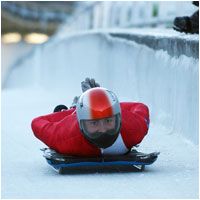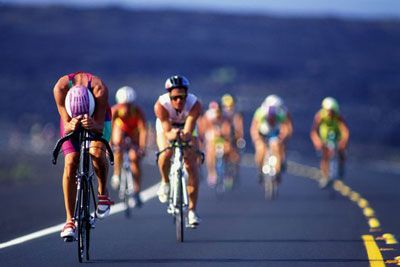Sliding has been part of the sports world since the early 1800's and continues to be an integral part of the international sports scene today. There are three sliding sports in the Winter Olympics: bobsleigh, skeleton and luge.
Because of the prone position of the slider (lying face down on the sled, head first with your arms back), skeleton might seem the most like the sort of recreational winter sledding you may have experienced. But, it's a lot more intense; approximately 80 miles per hour intense! Yep, that's right. Eighty miles per hour and your face is just inches from the ice as you barrel down the track. Here's how it works:
Advertisement
The sled is made of fiberglass or steel and has two steel runners along the bottom and two handles on top. (On some fiberglass models, the "handles" are actually two sides of a specially molded fiberglass shell that is made to fit an individual's particular physique.) Bumpers located on the front and rear of the skeleton act as shock absorbers and help protect the slider from the wall of the ice tunnel. The sled measures 3 feet in length by 16 inches wide and weighs between 70 and 115 pounds (this depends on the weight of the slider, as there's an overall weight limit).
The skeleton slider wears a very close-fitting, aerodynamic speed suit made of rubber and a durable helmet complete with visor and chin guard. Using spiked shoes, the skeleton slider runs as fast as he or she is able along 50m of ice. The slider is trying to build up as much momentum as possible. All the while, the slider is bent over, holding on to the skeleton by the handles or the sides, pushing it down the track.
After sprinting 50m, the slider must quickly board (stretch out onto) the sled without losing any of the momentum that has built up. Now it's time to barrel down the 1300m to 1500m ice tunnel/track. There are hairpin bends and "S" shaped curves in the track. The slider steers by slightly shifting his or her body weight to the left or right. At the end of the run, the slider slows the skeleton to a stop by dragging his or her feet along the icy track.
Skeleton events were part of the 1928 and 1948 Winter Olympics, but did not make the schedule again for many years. In 2002, skeleton returned to the Winter Olympic schedule with competitions for both men and women. For both the men's and women's competitions, the sliders make two runs in one day that are each timed to 0.01 seconds. The scoring and standings are decided based on the aggregate time of each player's two runs.
Advertisement


